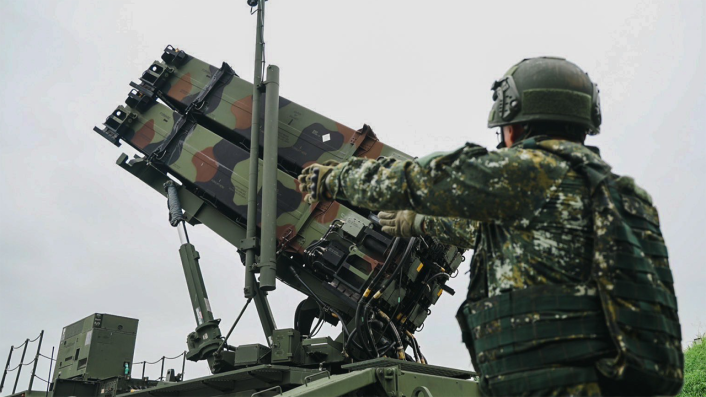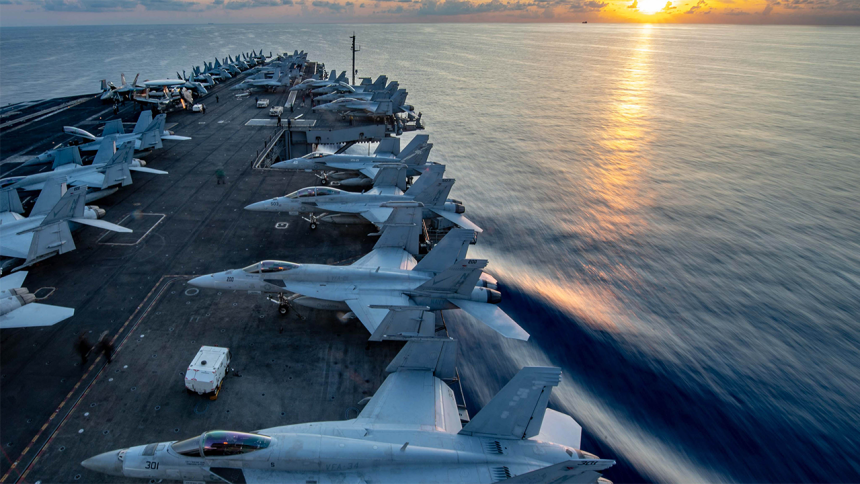The US Navy aircraft carrier steamed into the SCS (South China Sea) for “routine operations.” The flattop has been in the western Pacific region since earlier this year, holding exercises with Japan, South Korea and the Philippines.
China announced on Friday evening that it had concluded two days of military exercises around Taiwan. These maneuvers are broadly perceived as another attempt to pressure the democratically governed island and its allies.
Beijing, which regards Taiwan as a part of its own territory, described the Joint Sword-2024A drills as a “punishment” for the recent inaugural address by Taiwan’s new president, Lai Ching-te whose speech was referred to as a “confession of independence” by China.
In response, Taipei has condemned the military exercises, labeling them as a “unilateral provocation”.
China Conducts Massive Incursions
On Saturday, the RoC MND (Republic of China, Ministry of National Defense) reported that in the previous 24 hours “62 PLA aircraft and 27 PLAN vessels operating around” the island by early morning. Of those, 47 planes crossed the median line of the Taiwan Strait and entered its southwest, southeast and eastern ADIZ.
Leading PLA and Taiwan military analyst Ben Lewis, called it the “highest single-day number of median line crossings on record.” He added that this beat the number on December 25, 2022.that saw 37 incursions.
62 PLA aircraft and 27 PLAN vessels operating around #Taiwan were detected up until 6 a.m. today. 47 of the aircraft crossed the median line of #Taiwan Strait and entered Taiwan’s SW, SE, and eastern ADIZ. #ROCArmedForces have monitored the situation and responded accordingly. pic.twitter.com/JfUUGV1E3m
— 國防部 Ministry of National Defense, R.O.C. 🇹🇼 (@MoNDefense) May 25, 2024
The map released by the MND showed a long and bold flight path the plane/s followed (it is not clear if it was a single aircraft or a formation that conducted this flight). The route showed going parallel northwards along the median line, turning east crossing the boundary and turning southeast heading close to 39-km off Taiwan’s northernmost tip. The route then goes southwest before again traveling parallel southwards along the median line.
It then turns eastwards along Taiwan’s southwestern seaboard, goes past its southern coast and heads deeper into the western Pacific. At one point, the aircraft/s was 41-km off Taiwan’s southernmost tip. The route then retraces its journey, by turning back, following the same path, crossing the median line back into the Chinese side of the median line.
Two other routes drawn on the map show aircraft flying a rectangular path just bordering Taiwan’s median line (or the Chinese side of the line) in the far northern waters, in the southern part of the ECS (East China Sea). The other route showed a plane flying a square route, off the eastern waters of Taiwan. The make of this aircraft is also not known.
May 25 witnessed a far lesser and threatening formation: the MND detected seven PLA aircraft, 14 PLAN vessels and four CCG (China Coast Guard) vessels. An aircraft flight path on the map showed a rectangular route, up and down parallel to the median line, but staying within the Chinese side of the imaginary border. On both days, Taiwan “monitored” the situation, by “employing CAP (Combat Air Patrol) aircraft, Navy vessels, coastal missile systems.”
7 PLA aircraft, 14 PLAN vessels, and 4 CCG vessels operating around #Taiwan were detected up until 6 a.m. (UTC+8) today. #ROCArmedForces have monitored the situation and responded accordingly. pic.twitter.com/UdHLg2mgX8
— 國防部 Ministry of National Defense, R.O.C. 🇹🇼 (@MoNDefense) May 26, 2024
On May 24, Taiwan had released pictures of its F-16 Vipers, AH-64 Apaches and Patriot AD (Air Defense) batteries being readied as a part of its general military readiness response.

US Carrier Enters SCS
The US Navy aircraft carrier USS Theodore Roosevelt too steamed again into the SCS (South China Sea) for “routine operations.” The flattop has been operating in the western Pacific region since earlier this year, holding exercises with Japan, South Korea and the Philippines.
The USS Theodore Roosevelt, part of the US Navy 7th Fleet, “transited” the SCS on May 26, 2024, for “routine operations,” as the Chinese activities appeared to subside.
“US 7th Fleet is the US Navy’s largest forward-deployed numbered fleet, and routinely interacts and operates with allies and partners in preserving a free and open Indo-Pacific region,” said an official statement.
Sailors conducted “flight deck drills” on the carrier, while other pictures on social media showed an F/A-18 Super Hornet taking off. The carrier had been in the SCS until at least May 17. WarshipCam reported the carrier leaving Singapore on May 25. On March 19, the USN had reported the carrier completing its “250,000th successful arrested landing,” while in the SCS.
US Navy Cmdr. Brandon Miller, operations officer of Carrier Air Wing (CVW) 11, set the accomplishment, landing an F/A-18F Super Hornet. “Making the 250,000th arrested landing sends a strong message globally to our allies and adversaries that we can operate anywhere, anytime,” said Miller. “It shows the longevity and resilience we have, exhibiting how we can repeat the process very well and successfully.”









